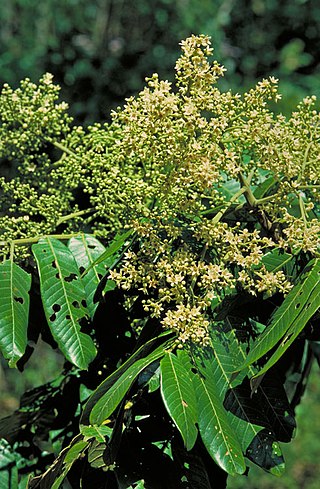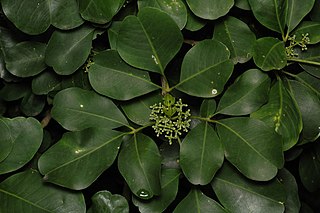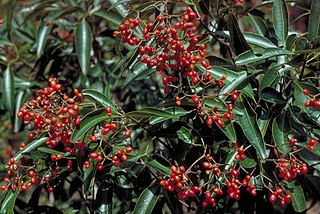
Flindersia ifflana, commonly known as hickory ash or Cairns hickory, is a species of tree in the family Rutaceae and is native to Papua New Guinea and Queensland. It has pinnate leaves with between four and twelve egg-shaped to elliptical leaflets, panicles of white or cream-coloured flowers and woody fruit studded with rough points.

Flindersia pimenteliana, commonly known as maple silkwood, red beech or rose silkwood, is a species of tree in the family Rutaceae and is native to New Guinea and Queensland. It has pinnate leaves with three to seven egg-shaped to elliptic leaflets, panicles of red or reddish flowers and fruit studded with rough points.

Flindersia schottiana, commonly known as bumpy ash, cudgerie or silver ash, is a species of rainforest tree in the family Rutaceae and is native to New Guinea and eastern Australia. It has pinnate leaves with mostly ten to sixteen leaflets, panicles of white flowers and woody fruit studded with rough points.

Flindersia brayleyana, commonly known as Queensland maple, maple silkwood or red beech, is a species of tree in the family Rutaceae and is endemic to northern Queensland. It has pinnate leaves with between six and ten leaflets, panicles of white or cream-coloured flowers and smooth fruit that opens in five sections to release winged seeds.

Acradenia euodiiformis, commonly known as yellow satinheart or bonewood, is a species of tree that is endemic to eastern Australia. It has mostly trifoliate leaves, the leaflets narrow elliptic to lance-shaped, with prominent oil glands, and panicles of white flowers. It grows in and near rainforest.

Melicope micrococca, commonly known as hairy-leaved doughwood or white euodia, is a species of shrub or slender tree in the family Rutaceae and is endemic to eastern Australia. It has trifoliate leaves and white flowers borne in panicles in leaf axils.

Syzygium hemilamprum, commonly known as the broad-leaved lilly pilly, blush satinash, cassowary gum, Eungella gum, and treated as Acmena hemilampra in New South Wales and Queensland, is a species of flowering plant in the family Myrtaceae and is native to New South Wales, Queensland and the Northern Territory. It is a rainforest tree with broadly lance-shaped to elliptic leaves, panicles of white flowers and more or less spherical white fruit.

Bulbophyllum baileyi, commonly known as the fruit fly orchid, is a species of epiphytic or lithophytic orchid that is native to Queensland and New Guinea. It has coarse, creeping rhizomes, curved, yellowish pseudobulbs with a single thick, fleshy leaf, and a single cream-coloured flower with yellow, red or purple spots. It grows on trees and rocks in open forest, often in exposed places.

Acronychia wilcoxiana, commonly known as silver aspen, doughwood, snowwood or mushyberry, is a species of small rainforest tree that is endemic to eastern Australia. It has simple, elliptical to egg-shaped leaves with the narrower end towards the base, relatively large groups of whitish flowers in leaf axils and broadly oval to more or less spherical, white fruit.

Melicope polybotrya is a species of shrub or small tree in the family Rutaceae and is endemic to Lord Howe Island. It has trifoliate leaves and green flowers borne in short panicles in leaf axils.

Bosistoa medicinalis, commonly known as the northern towra or Eumundi bosistoa, is a species of small to medium-sized rainforest tree that is endemic to Queensland. It has simple and pinnate leaves with two or three leaflets and panicles of small white flowers.

Acronychia acronychioides, commonly known as white aspen, is a species of small to medium-sized rainforest tree that is endemic to north-eastern Queensland. It has trifoliate leaves with elliptic to egg-shaped leaflets on stems that are more or less cylindrical, creamy yellow flowers in large groups in leaf axils and fleshy, pear-shaped or spherical fruit.

Acronychia imperforata, commonly known as Logan apple, Fraser Island apple, or green tree, is a species of rainforest shrub or small tree that is endemic to north-eastern Australia. It has simple, elliptical to egg-shaped leaves, small groups of yellowish or creamy white flowers and fleshy spherical to oval fruit.

Acronychia vestita, commonly known as white aspen, lemon aspen, hairy aspen or fuzzy lemon aspen, is a species of rainforest tree that is endemic to Queensland. It has simple, elliptic to egg-shaped leaves with the narrower end towards the base, flowers arranged in relatively large groups, mostly in leaf axils and fleshy, pear-shaped to more or less spherical fruit.

Bouchardatia neurococca, commonly known as union nut, is a species of small rainforest tree that is endemic to eastern Australia. It has pinnate leaves with three or five narrow elliptical leaflets, white flowers arranged in panicles, and oval follicles.

Coatesia is a genus of plant containing the single species Coatesia paniculata, commonly known as axe-breaker or capivi, and is endemic to eastern Australia. It is a small, evergreen tree with simple, elliptical to egg-shaped leaves, panicles of white flowers on the ends of branchlets or in leaf axils and fused follicles with one black seed in each follicle.

Dinosperma is a genus of plant containing the single species Dinosperma erythrococcum, commonly known as tingletongue, clubwood or nutmeg, and is endemic to north-eastern Australia. It is a tree usually with trifoliate leaves arranged in opposite pairs, the leaflets lance-shaped to oblong, and panicles of small white flowers, later bright orange to red, slightly fleshy follicles containing shiny, bluish black seeds.

Flindersia bourjotiana, commonly known as Queensland silver ash, northern silver ash, or white ash, is a species of tree that is endemic to Queensland. It has pinnate leaves arranged in opposite pairs and with between four and eight narrow egg-shaped to elliptic leaflets, greenish white flowers arranged in panicles, and fruit studded with short, rough points.

Cryptocarya mackinnoniana commonly known as Mackinnons laurel, Mackinnons walnut, rusty laurel, rusty leaved laurel, rusty leaved walnut or koonjoongaroo, is a species of flowering plant in the family Lauraceae and is endemic to north Queensland. It is a tree with oblong to narrowly elliptic to oval leaves, creamy green and pale brown, unpleasantly perfumed flowers, and elliptic black drupes.

Buchanania mangoides, commonly known as plum tree, is a plant in the mango and cashew family Anacardiaceae native to Queensland, Australia. It was first described in 1869.





















